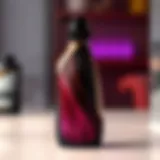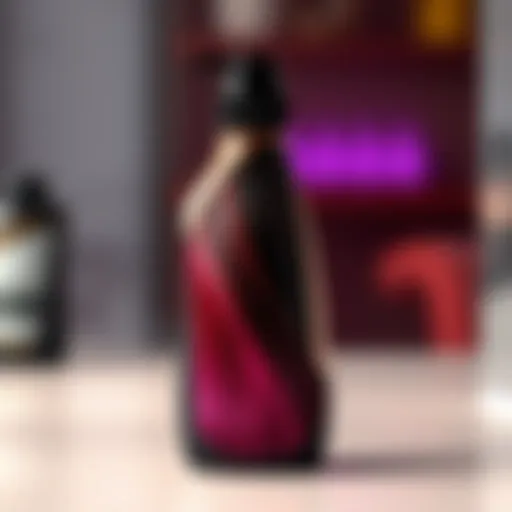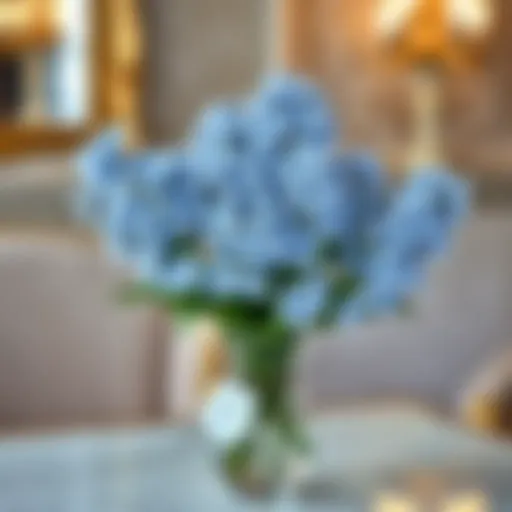Exploring the Art of Artificial Floral Swags for Decor
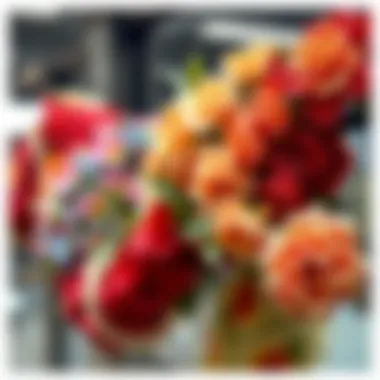
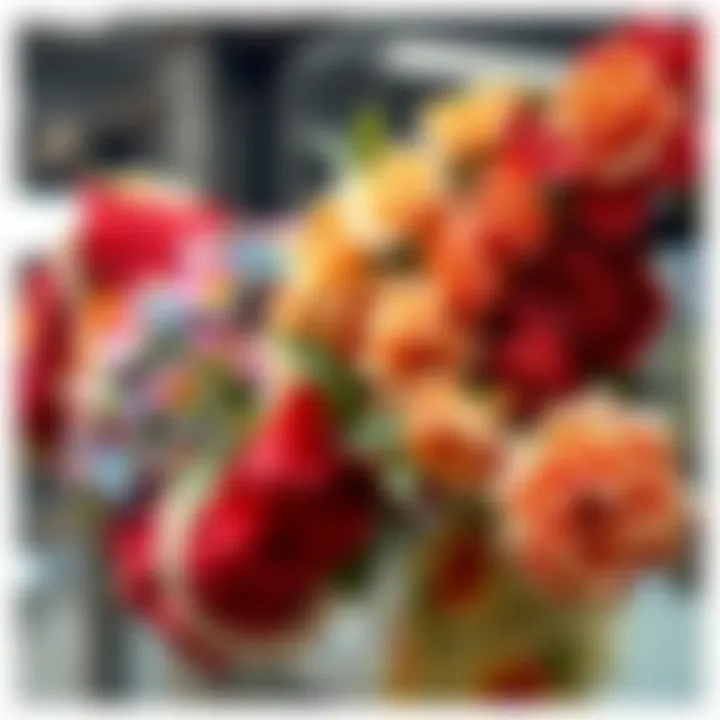
Intro
Artificial floral swags have emerged as a popular trend in both home decor and event styling. These elegant arrangements are not merely decorative; they carry a depth of practicality and aesthetic charm that can transform any environment, be it an indoor living room or an outdoor patio. With advancements in materials and design techniques, these swags have taken on a life of their own, going beyond the realm of imitation to become instant conversation starters. This article aims to dissect the many facets of artificial floral swags and showcase their diverse applications.
As we navigate through the historical context of floral decor, it becomes clear that the enduring appeal of floral designs stems from their ability to evoke nature's beauty without the constraints of seasonality. Artificial swags allow for endless creativity without the worry of withering or needing constant upkeep. As we delve deeper into this guide, you can anticipate rich insights into design techniques, sustainability, and tips for incorporating these swags into various settings. Our exploration will also shine a light on the evolution of artificial floral arrangements, inspiring readers to embrace and appreciate these stunning pieces in their own spaces.
Foreword to Artificial Floral Swags
Artificial floral swags, often viewed as mere decorative accents, actually hold deeper significance in both art and design. They serve not just as eye candy but also as a bridge between nature and artifice, highlighting the evolving tastes in interior decor. For those in the world of fashion, styling, or retail, understanding these arrangements is essential. Floral swags can transform a space, provide color, invoke emotions, and even facilitate storytelling through visual design.
Exploring the nuances of swags opens a Pandora's box of creative potential. Their versatility allows for individual expression, adapting to various themes, seasons, and occasions. In this article, we will delve into the intricacies of artificial floral swags—focusing on their definition, historical context, and contemporary relevance to decorators and designers alike.
Definition and Overview
Artificial floral swags are arrangements of artificial flowers, botanicals, and other decorative elements, typically crafted to hang either from a wall or in a window. These fully designed spectacles come in various shapes and styles, bringing texture and depth to any setting. Unlike traditional floral arrangements which have a finite lifespan, artificial swags are resilient, allowing for repeated use across seasons and celebrations.
The key components usually include a base frame, such as a garland or wreath, adorned with a combination of flowers, greenery, and accents that resonate with the intended tone of the space. This adaptability is what keeps designers experimenting with new trends and concepts in the floral domain.
Historical Significance
Historically, floral swags have roots deeply embedded in decorative arts. They date as far back as ancient times when nomadic tribes would adorn their living quarters with natural elements to invoke favors from nature. Different cultures have their own versions; for instance, in the Victorian era, floral swags took on a sophisticated twist, symbolizing wealth and status. Wrought iron and elegant silk flowers characterized these lavish displays, used in both public and personal domains.
As the years went by, the significance of floral swags evolved. They transitioned from a status symbol to a more accessible decorative option for the general public. In contemporary settings, swags reflect personal stories, cultural nostalgia, and artistic interpretations, tying together modern style with historical significance. The journey of floral swags, then, is not merely one of aesthetics; it weaves together threads of identity and purpose within spaces, setting the stage for rich narratives to unfold.
Materials Used in Artificial Floral Swags
When it comes to crafting stunning artificial floral swags, the materials selected play a pivotal role. The right combination not only enhances the visual appeal but also affects durability and maintenance. Understanding the materials used can help both enthusiasts and professionals alike create arrangements that are not just beautiful but also practical and enduring.
Silk vs. Polyester
Silk and polyester are two of the most commonly used materials in the creation of artificial floral swags. Each has its own unique characteristics that cater to different aesthetics and functional needs.
Silk flowers, renowned for their realistic look and feel, often mimic the delicate petals and vibrant colors found in nature. They bring a touch of elegance and class to any decor. However, they tend to be higher in cost than polyester options and may require more careful handling to maintain their appearance over time.
On the other hand, polyester flowers are notable for their resilience. They are generally less expensive and stand up better to wear and tear, making them a great choice for high-traffic areas or outdoor settings. While they may not have quite the same level of realism as silk, advancements in manufacturing techniques have allowed polyester to offer significant improvements in both texture and visual fidelity.
"Choosing the right material for your floral swag can make or break the overall impression it leaves. Take time to consider both aesthetic and practical needs."
Natural Elements Incorporation
Incorporating natural elements into artificial floral swags can elevate the design, blending the beauty of the outdoors with the convenience of artificial arrangements.
Wooden Accents
Wooden accents serve as a beautiful foil to artificial florals. They can add natural warmth and texture that softens the visual impact of synthetic flowers. The key characteristic of wooden accents is their versatility; they can be reclaimed, stained, or left in a natural state to match any design scheme. This makes them a popular choice for many designers, as they can seamlessly integrate into both rustic and modern aesthetics.
One unique feature of using wooden accents is the way they can introduce an organic feel to a design that otherwise relies on synthetic materials. This juxtaposition not only enhances the overall visual interest but also reflects a trend towards sustainability in decor choices. However, the challenge often lies in maintenance; untreated wood can be prone to moisture damage or warping.
Paper Flowers
Paper flowers are another delightful way to incorporate natural elements into artificial swags. They offer a handcrafted aesthetic that is both charming and imaginative. The key characteristic of paper flowers is their ability to be tailored in size, color, and shape, allowing for unique customization options.
The most appealing aspect of paper flowers is their lightweight nature, making them easy to arrange and transport. Additionally, they can cater to specific themes, perfect for seasonal celebrations or specific events. However, one's downside is that they can be less durable compared to other materials; exposure to moisture can cause them to become soggy and lose their shape.
Design Principles for Floral Swags
Understanding the design principles behind floral swags is key in creating an arrangement that captivates and enchants. When integrating artificial floral swags into various settings, thoughtful design elements can enhance their aesthetic allure and practicality. The design process is not merely about assembly; it involves a finer artistic touch grounded in theory and technique. Paying heed to these principles makes it easier to achieve an end result that not only looks stunning but also evokes the right sentiments in the space.
Color Theory Application
The power of color in design can not be overstated. In artificial floral swags, color sets the tone, energizes the atmosphere, and draws attention to the arrangement. Through color theory, designers can strategically pair hues to create visual harmony or striking contrasts that resonate.
- Complementary colors, like rich purples with vibrant yellows, create a dynamic interplay that can energize a room.
- Analogous colors, such as various shades of reds and oranges, can impart feelings of warmth and comfort, making them ideal for cozy settings.
Once the primary palette is selected, consider the application of color gradients or ombre effects. This technique can provide depth, transitioning smoothly from one tone to another, ensuring the swags are not only visually appealing but also carrying a sense of movement.
Layering Techniques
Layering is where the magic happens in floral design. When crafting floral swags, it’s essential to explore the arrangement in layers, as it creates a sense of depth rather than a flat composition. Techniques include:
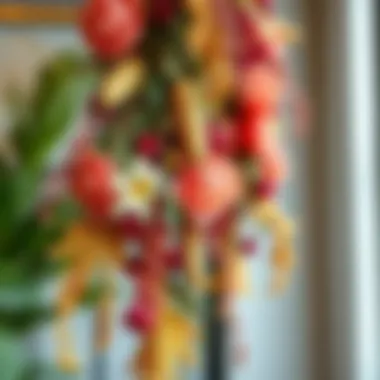
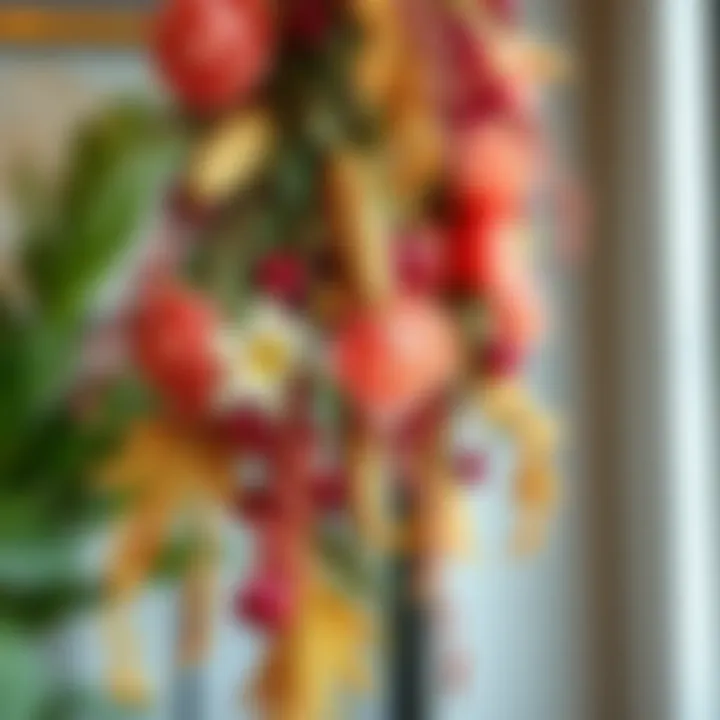
- Base Layer: Start with greenery and fillers to lay the foundation, which provides volume and a lush backdrop for the main flowers.
- Mid Layer: Next, add larger blooms or statement pieces to establish focal points. They draw the eye naturally, serving as the 'stars' of the arrangement.
- Top Layer: Finish off with delicate accents or trailing elements that enhance the graceful fall of the swag, creating a soft, organic feel.
The interplay between these layers creates a swaying motion, captivating the viewer's interest without overwhelming their senses. Thus, layering not only adds visual complexity but also enriches the swags' storytelling aspect.
Balance and Proportion
Achieving balance and proportion is vital in floral design. A well-balanced swag conveys a sense of harmony that is pleasing to the eye. Consideration of visual weight is paramount—this refers to how heavy or light a design feels based on size, color, and texture. There are two types of balance to keep in mind:
- Symmetrical Balance: Achieved by mirroring elements on either side, this method creates a sense of order and sophistication.
- Asymmetrical Balance: For a more dynamic look, designers can arrange elements of varying sizes on either side in a way that still feels balanced overall.
Furthermore, considering proportion means examining the relationship of the elements in the swag. For instance, large blooms should not be overwhelming in the presence of smaller elements; instead, they should complement each other, showcasing the diversity in size without causing chaos.
Crafting Your Own Artificial Floral Swag
Crafting your own artificial floral swag can be a rewarding venture, allowing you to express your creativity while adding a unique touch to your space. This section dives into the essential tools, the step-by-step process, and personalization techniques to guide you along the way. Making your own swag not only unveils your artistic flair but can also be budget-friendly compared to store-bought options. When you craft it, you dictate the colors, styles, and materials used, making it a true reflection of your personal taste.
Essential Tools and Supplies
To get started with creating your floral swag, having the right tools at hand is crucial. First off, floral wire and hot glue guns are your best friends—trust me, they’ll help attach everything securely without fuss. A pair of scissors or wire cutters will come in handy, too; you don’t want to be caught here without them.
You'll also need an assortment of materials:
- Silk flowers or polyester blooms (these last longer than real ones)
- Greenery, like eucalyptus or ferns, to give that earthy feel
- Base structure, such as a foam or a vine wreath to build upon
- Decorative accents, like ribbons or even seasonal elements (think pine cones for winter!)
Collecting all these items before you begin will save you from running back to the store mid-process.
Step-by-Step Creation Process
- Select Your Base: Start with your foam or wreath base. This will determine the overall shape and foundation of your swag.
- Prepare Your Flowers: Trim the floral stems to your desired length. Generally, shorter stems work better for fuller swags.
- Assemble Your Greens: Attach greenery along the edges of your base to start defining the shape. Use floral wire to bind them securely.
- Layer Your Flowers: Begin placing your selected flowers into the arrangement. Layer them, filling in gaps as you go along to create depth. The rule of thumb is to start with larger flowers and fill in with smaller ones.
- Finalize With Details: Add any decorative accents last, ensuring they complement the flowers and don’t overwhelm the composition.
- Secure and Display: Once you’re satisfied, secure everything in place with glue or more floral wire, and find a statement spot for your swag.
"Creativity is contagious, pass it on." – Albert Einstein
Personalization Techniques
Choosing a Theme
Choosing a theme when crafting your swag gives it direction and coherence. This aspect plays a pivotal role in ensuring that every element—from colors to types of flowers—harmonizes. A chosen theme can reflect seasons, events, or even personal memories.
For example, a rustic theme could incorporate earthy tones like browns and greens with wildflowers, while a glamorous theme might feature glossy silk flowers in bold colors paired with shiny metallic finishes. Tailoring your swag to a specific theme not only enhances aesthetics but also creates emotional resonance for viewers.
Adding Sentimental Items
Integrating sentimental items into your swag introduces personal history and depth. Think about including trinkets from an event or souvenirs from travels, such as mini seashells or dried flowers received from a loved one.
The key characteristic of this personalization technique is that it transforms the swag into a storytelling piece. However, care should be taken to ensure these items do not clash with floral elements, allowing them to complement rather than compete. This aspect adds an extra layer, inviting viewers to engage and inquire about the elements featured. For instance, a shell placed among ocean-toned flowers might pique curiosity and evoke shared memories.
Both choosing a theme and adding sentimental items create a unique experience that elevates the simple act of crafting a floral swag into a meaningful creative expression.
Applications of Artificial Floral Swags
Artificial floral swags are not merely decorative pieces—they serve a variety of purposes in enhancing the aesthetic and functional elements of spaces. Understanding their applications sheds light on why these arrangements are gaining traction among decorators and homeowners alike. The versatility of floral swags can elevate home decor, serve as focal points in events, and provide seasonal cheer through carefully curated designs.
Home Decor Enhancements
Entryways
Entryways are the first impression of any home, much like how a book cover invites one to read further. Incorporating floral swags in these spaces creates an inviting atmosphere that speaks to the personality of the homeowners. The floral swags can frame doors or hang above, drawing the eye and enhancing the charm of the entryway. A standout feature of floral arrangements in this area is their ability to set the tone—soft pastels for a serene vibe or vibrant hues for an energetic feel. Despite being low-maintenance, they also carry an impact, making them a popular choice for those who want to treat guests to aesthetic delight upon arrival. The disadvantage, however, may present itself if the swags clash with other decor elements. It's crucial to maintain a cohesive style to avoid overwhelming the senses.
Walls and Ceilings
When considering walls and ceilings, floral swags extend their artistry beyond horizontal spaces and dive into vertical dimensions. Decorating these surfaces can transform an ordinary room into a sanctuary of creativity. The dramatic presence of a wall swag can provide a stunning backdrop or a ceiling décor that brings added texture and depth to high-reaching spaces. Walls adorned with artificial floral swags become conversation starters, while ceilings festooned with them foster an illusion of grandeur. Notably, these installations help soften areas that might feel stark or empty. However, placement must be calculated to ensure it doesn’t overwhelm the existing structure. Too much might lead to a cluttered feeling, making it essential to strike a balance between decor and openness.
Event Decor Usage
Weddings
Weddings often symbolize the joining of two lives, and floral swags play an integral role in celebrating this momentous occasion. They can be used to enhance archways, centerpieces, or pew decorations. The delicate craftsmanship of swags mirrors the beauty of the day, with skilled designers tailoring arrangements that resonate with the couple's theme. Moreover, the longevity of artificial flowers means that couples can keep these keepsakes long after the last dance, providing a lasting memory. Yet, one must consider the light in which they are displayed; if not carefully orchestrated with natural lighting, the artificial elements may not convey the same warmth and authenticity as fresh flowers.
Corporate Events

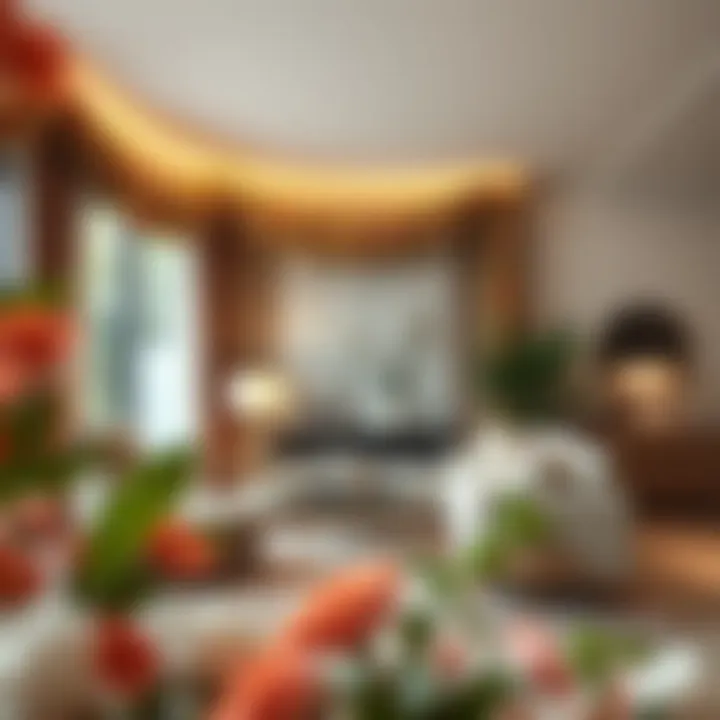
In corporate contexts, floral swags lend an air of professionalism infused with a touch of warmth. They are often utilized in conference rooms, exhibitions, and corporate gatherings to break away from stark industrial environments. The fresh feel they provide can help dampen tension during high-stakes meetings or promote a friendly atmosphere for networking. They also allow brands to express identity through colors and arrangements that align with company ethos. However, it’s important not to overshadow branding messages with excessive decoration; floral swags should support, not deter, the corporate narrative.
Seasonal Celebrations
Spring and Summer Themes
Spring and summer themes are ideal for incorporating floral swags as they resonate with the rejuvenation and vibrancy of these seasons. Bright colors and lively blooms used in floral arrangements encapsulate the spirit of rejuvenation and warmth. These swags can be used not merely for decoration but also as centerpieces that embody seasonal transition. The benefit of employing such designs is the instant uplift they provide to any gathering—from outdoor barbecues to garden parties. It's a simple and effective way to bridge the indoor and outdoor spaces beautifully, even if one dislikes the hassle of changing decorations frequently. A drawback, however, may arise during extreme weather conditions where artificial swags could fade or become damaged if forgotten outdoors.
Autumn and Winter Variations
Autumn and winter variations in floral swag applications highlight deeper shades and textured materials that reflect the seasons’ richness. Swags can incorporate items like pinecones or dried leaves alongside artificial flowers, providing a more festival-focused aesthetic. For autumn, swags can add warmth to spaces while cool winter designs often lean towards iridescent whites and soft blues, creating a sense of calmness. These arrangements foster intimacy and are effective in elevating holiday spirit—think there’s nothing quite like stepping into a home decked out with autumn golds or winter whites. The downside may lie in the seasonal nature of the decorations; switching themes frequently can become a chore, especially for those pressed for time.
In summary, the applications of artificial floral swags stretch far and wide, enriching spaces in innovative ways throughout various contexts from home to events, making them a worthy consideration for anyone looking to adorn their surroundings.
Maintaining Artificial Floral Swags
Maintaining artificial floral swags is an integral part of ensuring their longevity and visual appeal. Just like any other decorative piece within your home or event, these swags require care to keep them looking fresh. This maintenance not only contributes to the aesthetic value but also reflects the overall ambiance of the space they inhabit. Moreover, properly maintaining these swags allows for the preservation of the materials used, safeguarding your investment over time.
Cleaning Techniques
Cleaning artificial floral swags is essential in keeping them vibrant. Dust tends to accumulate on their surfaces, diminishing their beauty. Regular maintenance can be quite straightforward. For basic cleaning, a soft cloth or a feather duster can effectively remove dust without damaging delicate components. For a deeper clean, a mild soap solution can be employed; however, it’s paramount to minimize moisture, as excessive water might damage certain synthetic materials.
Remember: Use a gentle touch when handling the swags to prevent any breakage or bending of the design elements.
Storage Recommendations
Proper storage is key to maintaining the integrity of artificial floral swags, particularly when they are not in use. There are two primary aspects to consider in this category: short-term storage and long-term preservation.
Short-term Storage
Short-term storage primarily caters to the need for organized and neat arrangements when the swags are not displayed. A notable characteristic of this storage method is that it is relatively quick and easy. Swags can often be stored in a breathable bag or box that keeps them safe from dust and potential damage. The beauty of this approach lies in its convenience; you can quickly access them for upcoming occasions without much fuss. However, it’s wise to ensure that the swags are not crammed together, as overcrowding could lead to creasing or warping.
Advantages of short-term storage include:
- Easy access for rapid decoration changes.
- Minimal effort in securing the items.
- Less chance of material degradation.
Long-term Preservation
Long-term preservation addresses the need for maintaining swags over extended periods when they may not be required for display. This approach often involves more deliberate organization. One of the main attributes of this storage method is the protective measures taken to extend the lifespan of the swags significantly. Swags can be wrapped in acid-free tissue paper and stored in a dark, cool place to prevent color fading and material breakdown. While this option requires a bit more effort, the returns in terms of longevity are worth it.
Consider the following when engaging in long-term preservation:
- Store in a climate-controlled environment to minimize humidity effects.
- Utilize protective wrapping to avoid damage during handling.
- Conduct periodic checks to ensure no degradation occurs.
Maintaining artificial floral swags through proper cleaning and storage not only enhances their aesthetic but ensures they remain a beloved part of your decor for years. The time devoted to care will certainly pay off, as these creations should bring joy and beauty rather than frustration of decay.
Sustainability Considerations
When exploring the realm of artificial floral swags, one aspect that should never be overlooked is sustainability. In an era where environmental concerns are at the forefront, the way we approach home decor and events has a profound impact on our planet. By incorporating sustainable practices in the creation and use of artificial floral arrangements, we can enjoy their beauty while minimizing ecological footprints.
Eco-friendly Materials
The selection of materials is critical when it comes to crafting artificial floral swags. Traditional sources of decorative items often rely on petroleum-based plastics, which can take centuries to decompose and contribute significantly to pollution. However, the landscape is changing.
There are a variety of eco-friendly materials that can be utilized to create artificial floral swags:
- Bamboo: A fast-growing resource, bamboo is biodegradable and renewable. Its lightweight nature makes it great for various types of floral arrangements.
- Recycled Fabrics: Using recycled polyester or cotton not only prevents waste but also brings a unique aesthetic to floral designs. This method transforms discarded materials into art.
- Plant-Based Plastics: Some manufacturers are turning to bioplastics, derived from renewable resources like corn or sugarcane. These materials break down more easily than standard plastics when exposed to the right conditions.
Employing such sustainable materials does not mean sacrificing quality or beauty. Many designers are blending these eco-friendly components seamlessly with traditional floral elements, resulting in arrangements that are as visually captivating as they are environmentally conscious.
Long-term Impact Assessment
Understanding the long-term implications of using artificial floral swags is vital for conscientious consumers and creators alike. Choosing sustainable materials is only one piece of the puzzle. It’s equally important to consider the life cycle of these decorations.
Artificial floral arrangements have a unique durability compared to their natural counterparts. While real flowers wilt and need replacement, quality artificial floral swags can last for years when maintained properly. This longevity can be advantageous from both an economic and ecological standpoint. By reducing the frequency of production and disposal, one can achieve a smaller carbon footprint over time.
Furthermore, evaluating the sourcing, production, and disposal methods used for artificial floral components leads to a better understanding of sustainability:
- Sourcing: Look for suppliers who adhere to sustainable practices, such as using eco-friendly materials or supporting local economies.
- Production: Manufacturing processes should minimize waste and utilize energy-efficient operations.
- Disposal: Consider how the materials can be reused, recycled, or disposed of responsibly at the end of their life cycle.
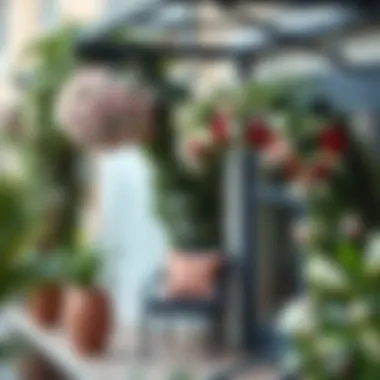
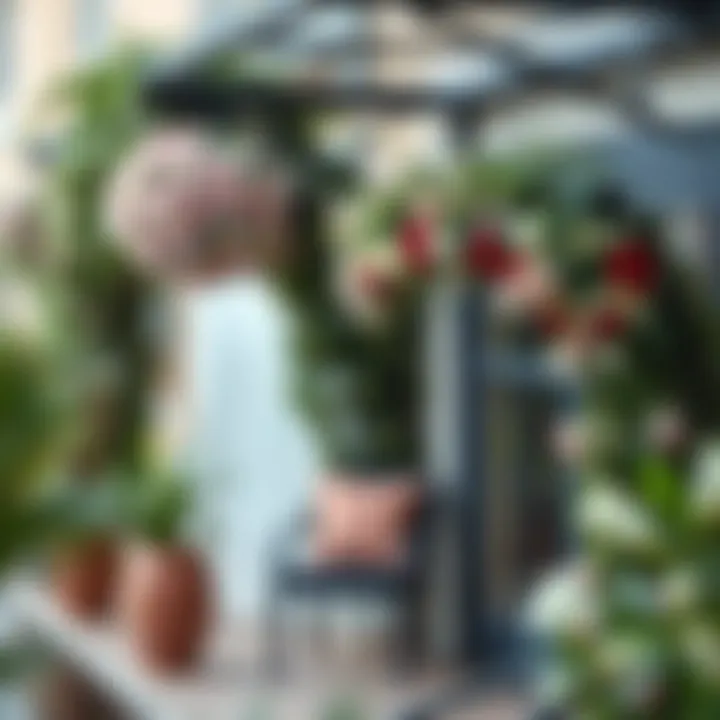
Just like a well-cared-for garden, an awareness of sustainability nurtures our decorative choices and helps the planet flourish.
Current Trends in Artificial Floral Design
In the fast-paced world of design, where aesthetic preferences shift like the tides, artificial floral swags are experiencing a renaissance. This section dives into the contemporary paradigms that shape the artistry of these arrangements, shedding light on how current trends can breathe new life into both personal and commercial spaces.
The popularization of artificial floral designs goes beyond mere decoration; it serves as a representation of evolving tastes and environmental considerations. With sustainability at the forefront, the innovation in materials and design techniques is reshaping how consumers and designers approach floral decorations.
Minimalism and Simplicity
Less truly can be more. The trend of minimalism emphasizes clean lines, simple forms, and an overall understated elegance. In the realm of artificial floral swags, this translates to arrangements that feature a few carefully selected elements, rather than an overwhelming profusion of colors and shapes.
The charm of minimalism lies in its ability to draw attention to each flower and accent. For instance, using a single type of blossom in soft pastel tones, accented with fresh greenery, can create an ambient look that fills a space with tranquil energy. This simplicity not only appeals aesthetically but also resonates with a broader audience who seek a more peaceful environment.
- Consider the following points when integrating minimalist principles into floral swags:
- Choose a limited color palette for cohesiveness.
- Utilize negative space to enhance visual interest.
- Incorporate varied textures to maintain depth.
Incorporating these elements can elevate the sophistication of a space, whether it be a cozy corner in a home or an elegant lobby in a corporate setting.
Mixing Natural and Artificial
Another notable trend is the beautiful juxtaposition of natural and synthetic elements. This approach allows for a dynamic blend that capitalizes on the advantages of both worlds. By incorporating real branches or organic materials with artificial flowers, designers achieve a unique aesthetic that balances realism and creativity.
This marriage of the two materials encourages innovative designs that can withstand the test of time while reducing maintenance concerns. For example, by pairing lifelike silk blooms with actual twigs, one can create striking displays that maintain their allure year-round, regardless of seasonal changes.
Consider incorporating this trend in the following ways:
- Use physical branches as a base for swags, interwoven with artificial blooms.
- Combine dried elements like lavender or wheat with refined silk flowers for a textural contrast.
This blending reverberates with current consumer habits, as individuals seek authentic experiences while balancing practicality. By observing trends like minimalism and the mixing of natural elements, one can stay ahead in the flourishing field of floral design.
"The art of floral arrangements lies in the balance, where simplicity meets complexity, and nature embraces artistry."
Such innovative approaches not only inspire creativity among designers but also cater to a discerning clientele that values individual expression and sophistication in their décor.
Inspirational Examples of Floral Swags
When it comes to the world of artificial floral swags, inspiration can strike from various sources. The sheer range of innovative designs available today showcases not only the artistic flair of designers but also the limitless possibilities within this decorative realm. This section aims to highlight the importance of these examples and how they serve as a driving force in enhancing one's personal or professional decor.
Artificial floral swags are not merely decorative items; they are manifestations of creativity and vision. By examining diverse examples, we can appreciate how specific elements—like color, texture, and the arrangement—play a crucial role in the final outcome. Moreover, they reveal essential benefits such as accessibility, sustainability, and versatility when it comes to decorating spaces.
"Inspiration can be found in unexpected places; a beautiful swag can turn any mundane corner into a vibrant statement."
Innovative Designs from Flora Experts
When seasoned floral designers engage in creating artificial swags, their expert touch elevates the art to an entirely different level. One notable example is the lavish swags showcased by Jane Packer, a name synonymous with floral elegance. Her use of various textures—ranging from soft silk blooms to delicate faux foliage—creates striking visual contrasts that grab attention immediately.
Incorporating the theory of color, experts often harmonize hues that reflect the season or occasion. For instance, swags filled with orange and yellow shades during autumn can add warmth and visual richness to any space. Beyond color, texture plays a vital role. Flora specialists often mix materials like velvet and linen along with plastics to craft designs that invite a second look. The effective layering of these elements mirrors the complexities found in natural arrangements, allowing spectators to feel a sense of connection to the natural world.
A well-known trend among florists currently includes creating asymmetrical designs that make a bold statement. This approach often breaks away from traditional symmetrical styles to provide a modern twist that resonates well in contemporary spaces.
User-Generated Creations
While expert designs showcase a polished aesthetic, user-generated creations tell another story. These examples often reflect personal stories, cultural backgrounds, and unique tastes. For instance, a simple swag assembled from recycled materials may carry an emotional weight that differs significantly from a commercially available product. These homemade arrangements allow individuals to express themselves and their values.
Many enthusiasts share their creations on social media platforms, transforming digital spaces into inspirational hubs. On Instagram or Pinterest, the hashtag #DIYFloralSwag helps highlight the creativity of everyday users. Each entry tells a story—some revolving around family traditions while others may speak to individual artistic exploration.
User-generated content also encourages innovation. A casual browse on Reddit can reveal countless ideas, ranging from unique theme choices to unconventional item incorporation. For instance, turning old jewelry into intricate embellishments for a floral swag can transform a nostalgic artifact into something new and beautiful.
Finale and Final Thoughts
Artificial floral swags embody a fusion of creativity and practicality, making them relevant in a multitude of settings. This article has traversed various dimensions of artificial floral swags, from their historical roots to the nuanced crafting techniques employed by enthusiasts. As we wrap up, it’s essential to spotlight the significance of understanding these elements, especially for those who are keen to incorporate them into their spaces or professional designs.
The journey through materials, design principles, and current trends has showcased how artificial floral swags are not just decorations, but statements of style and sustainability. Integrating eco-conscious materials and thoughtful design not only enhances aesthetic appeal but also aligns with the growing demand for sustainable practices in home and event decor. With their versatility, these swags can adapt to any season, occasion, or personal theme, providing endless opportunities for customization.
Reflecting on the importance of this topic, it’s clear that whether one is a fashion designer, a stylist, a blogger, or an educator, understanding artificial floral swags enriches one’s design repertoire. They allow for a unique personal touch, transforming environments without the constraints that live flowers might impose.
"Creativity is intelligence having fun." - This age-old idea certainly applies to the world of artificial floral arrangements, where design meets innovation.
In moving forward, we hope to inspire a new wave of creativity that embraces both tradition and modern sustainability, creating spaces reflecting individual stories through the art of floral swags.
Recap of Key Points
- Definition and Significance: Artificial floral swags serve as versatile decorative elements, rooted in historical significance.
- Material Selection: Choice between materials like silk and polyester deeply affects the appearance and durability of arrangements.
- Design Principles: Utilizing color theory, layering techniques, and achieving balance are crucial for creating stunning swags.
- Crafting and Personalization: Understanding tools and crafting steps allows for tailored creations that resonate personally.
- Sustainability: Opting for eco-friendly materials positively impacts both the environment and aesthetic appeal.
- Current Trends: Embracing minimalism alongside the mix of natural elements highlights the evolving landscape of floral arrangements.
Future of Floral Decorations
As we gaze into the future, artificial floral decorations are poised for transformation through technological advancements and changing consumer preferences. Current trends point toward a desire for minimalistic yet impactful designs, suggesting a shift away from over-the-top arrangements. People are increasingly seeking authenticity and personalization, driving the trend of incorporating natural elements alongside artificial enhancements.
Moreover, the integration of smart technology such as augmented reality could reshape how we interact with floral decor, allowing users to visualize swags in their spaces before committing to their designs. This could democratize floral design, making it accessible for all to experiment and innovate.
In essence, the future lies in balancing aesthetics with sustainability, allowing for beautiful spaces that do not compromise on environmental responsibility. As society continues to navigate climate challenges, the demand for eco-conscious designs will undoubtedly shape the evolution of floral decorations, ensuring they remain relevant in contemporary decor.
